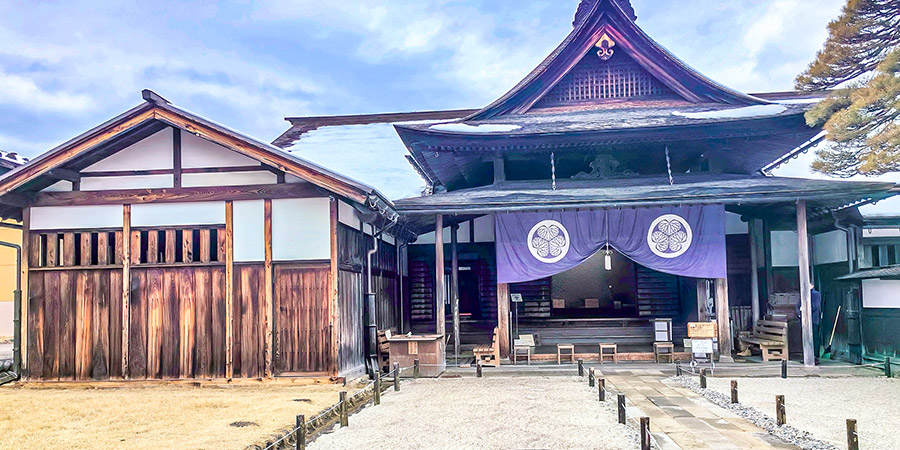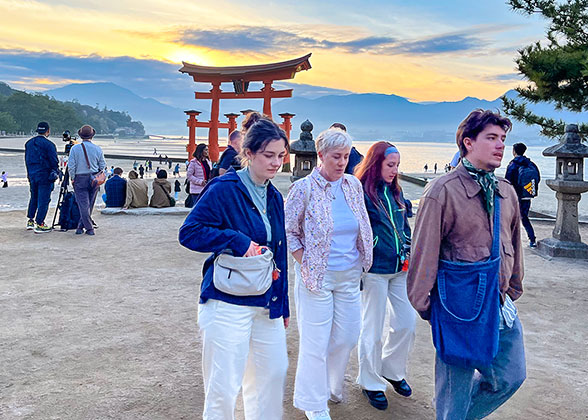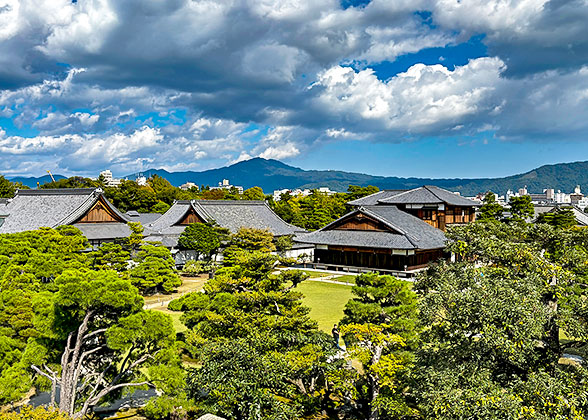Takayama Jinya
Takayama Jinya is the only remaining ancient government office in Japan, consisting of the office area, living area and one rice storehouse. Initially built in 1615, Takayama Jinya has more than 400 years of history. Originally, it was the residence of the ruler of Takayama. While beginning from 1692 and for the next 277 years, it worked as a government office for 4 dynasties: Edo Period (1603 – 1868), Meiji Period (1868 – 1912), Taisho Period (1912 – 1926), and Showa Period (1936 – 1989).

Takayama Jinya
|
Office Area
Main rooms: Entranceway, Government Office, Official Business Room, Office for Scribes, Guest Room, Living Room, Law Court and Interrogation Room, and Reception Hall
In the area, officials dealt with government affairs like collecting taxes, writing documents, and investigating criminals.
|
|
|
Must-sees in Office Area
1. Classic Blue Seigaiba Pattern in the Edo Period
At the entrance, there is one 4.5-meter-wide (4.9 yards) restoration of the Seigaiba painting. Seigaiba is the wave pattern popular during the Edo Period, as people believed that it could bring prosperity and long peace. Want to see the original one? Then go to Rice Storehouse.2. Law Court and Interrogation Room
Law Court and Interrogation Room has two parts: one is used for receiving citizens’ requests and complaints, and the other is to judge criminals. Here displays the original torture tools weaved with bamboos to intimidate criminals and the stones for them to kneel on.

Interrogation Room
|
3. Reception Hall
Among the various rooms, the Reception Hall is the largest for important yearly events and most suitable for appreciating scenery in the garden.
|
|
|
Living Area
Main rooms: Living Room of Officials’ Wives, Living Room of the Head Official, Maids’ Room, Kitchen, Envoy RoomOfficials, their family members, and servants lived here.
|
|
|
Don’t Miss "Mamuki Rabbits" on the Heads of Nails and Different Tatami Mat Patterns
On the surface of all Nageshi that connects pillars, there is always a cute rabbit-shaped decoration, which is common in traditional Japanese houses, as the strong fertility of rabbits symbolizes people’s wishes for family thriving. Children may have fun counting them. In addition, the patterns of Tatami mats are in various forms, and by observing them, you can infer the social status of those who once lived here. The more delicate these mats are, the higher positions may these owners be.

Tatami Mats
|
Rice Storehouse
As Japan’s oldest and largest rice storehouse built in the 17th century, it displays the delicate technique and wisdom of wooden artisans in Hida. Without using even one nail, the roof of the storehouse is consolidated with wooden sticks and stones.What to Do around Takayama Jinya
1. Stroll around the Jinya Morning Market
Jinya morning market is suitable to feel the local customs as here is often gathered by local people. The market is mainly made up of about 50 stalls selling local agricultural products, like fresh vegetables, fruits, flowers, and rice. The most recommended products are apples, which are especially juicy and sweet. In addition, don’t miss the Jinya dumplings, which are grilled and tasty, eating with soy sauce. You can also buy a Sarubobo doll, the local mascot that is said to bring joy to families, especially pregnant women.2. See Sakura on Nakabashi Bridge
Apart from the garden inside Takayama Jinya, Nakabashi Bridge nearby is also a good choice to appreciate Sakura, which is only 80 meters (88 yards) far from Takayama Jinya. The red Bridge crosses the Miya River, along which Sakura trees grow. From April 1st to May 6th (except April 14th), there are also illumination activities along the Miya River. At night, the colorful illumination lights make the pink flowers take on another beauty.Opening Hours
April – October: 8:45 a.m. – 5:00 p.m.November – March: 8:45 a.m. – 4:30 p.m.
Note: Ticket service will stop 30 minutes before Takayama Jinya is closed.
Ticket Price
440 yenTip
Free English guiding and introduction service by docents is offered, but remember to reserve the service in advance and come to Takayama Jinya at least 2 hours before it is closed for the service.How to Get There
1. Train
Take Limited Express Hida to Takayama Station and walk for about 10 minutes: walk southward along the Hirokoji Street for about 50 meters (55 yards); then, turn east and walk for 500 meters (550 yards) still along the Street; at last, turn south, walk for 150 meters (165 yards), and Takayama Jinya is on your southwest.2. Bus
Take Kintetsu Bus/JR Tokai Bus/Keio Bus to Takayama Nohi Bus Center and walk for 10 minutes: head south toward 74 Road for about 45 meters (50 yards); then, walk along the 74 Road toward south for about 120 meters (130 yards); later, turn right and walk along Hirokoji Street for about 500 meters (550 yards); at last, turn south, walk for 150 meters (165 yards), and Takayama Jinya is on your southwest.
Nearby Tourist Attraction
Sanmachi Suji
Sanmachi
Suji is an ancient district consisting of three streets. Here, you can not only
see typical buildings with more than 400 years of history, but also taste
delicious Hida beef and sake. Taking a pulled rickshaw – the traditional
vehicle here, might be interesting. In addition, there are many craft shops
along the streets, so don’t miss them.
You May Like
-
 10 Days Private Tour of Tokyo - Mt. Fuji - Nagoya - Takayama - Shirakawa-go - Kanazawa - Kyoto - Nara - Hiroshima - Osaka from USD3756
10 Days Private Tour of Tokyo - Mt. Fuji - Nagoya - Takayama - Shirakawa-go - Kanazawa - Kyoto - Nara - Hiroshima - Osaka from USD3756 -
 11 Days Mini Group Tour to Tokyo - Hakone (Mt. Fuji) - Kyoto - Nara - Osaka - Hiroshima - Kanazawa - Shirakawa-go - Takayama - Tokyo from USD3554
11 Days Mini Group Tour to Tokyo - Hakone (Mt. Fuji) - Kyoto - Nara - Osaka - Hiroshima - Kanazawa - Shirakawa-go - Takayama - Tokyo from USD3554 -
 8 Days Mini Group Tour to Tokyo - Hakone & Mt. Fuji - Kyoto - Nara - Osaka - Hiroshima - Osaka from USD2771
8 Days Mini Group Tour to Tokyo - Hakone & Mt. Fuji - Kyoto - Nara - Osaka - Hiroshima - Osaka from USD2771

